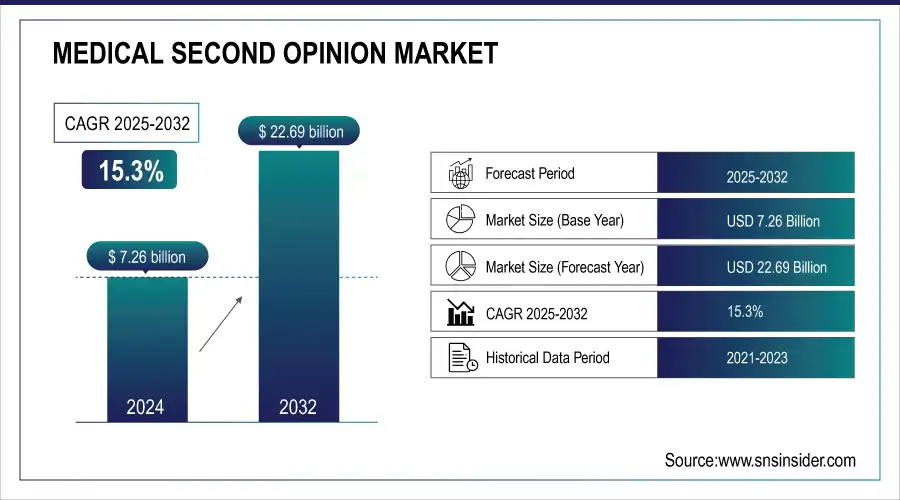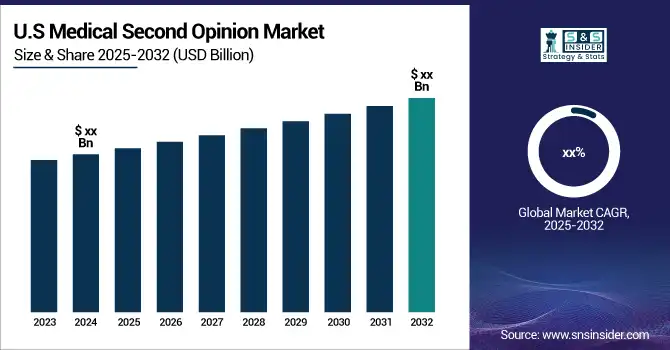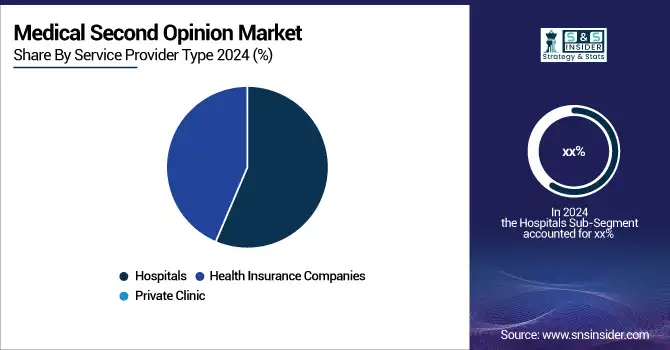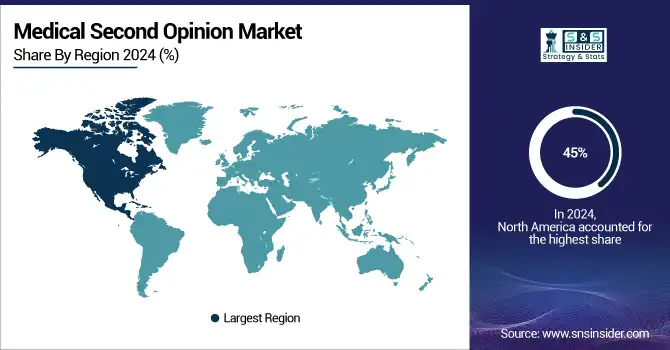Medical Second Opinion Market Overview
The Medical Second Opinion Market was valued at USD 7.26 billion in 2024 and is expected to reach USD 22.69 billion by 2032, growing at a CAGR of 15.3% from 2025-2032.
The medical second opinion market is driven by growing patient awareness and the rising prevalence of complex and chronic diseases. Increasingly, patients seek multiple consultations to ensure accurate diagnosis and tailored treatments, especially for serious conditions like cancer and tumors. Advances in digital health platforms enable virtual second opinions, while partnerships among leading players expand access. Technological progress allows precise diagnoses and targeted therapies, making cross-consultation essential. Differences in doctors’ opinions and the complexity of diseases further encourage seeking expert advice. Patients primarily pursue second opinions for peace of mind, treatment confidence, and improved health outcomes.

Get more information on Medical Second Opinion Market - Request Sample Report
Medical Second Opinion Market Trends
-
Rising patient awareness and demand for expert consultations are driving medical second opinion adoption.
-
Integration of telemedicine and digital health platforms is enabling remote access to specialists.
-
Increasing prevalence of chronic and complex diseases is boosting market growth.
-
AI and data analytics are enhancing diagnostic accuracy and personalized treatment recommendations.
-
Expansion of insurance coverage and reimbursement for second opinions is encouraging utilization.
-
Hospitals and healthcare providers are collaborating with second opinion platforms to improve patient trust and outcomes.
-
Growing focus on reducing misdiagnosis and treatment errors is accelerating adoption globally.

Medical Second Opinion Market Growth Drivers
-
Growing Patient Awareness and Rising Demand for Quality Healthcare Services Are Significantly Driving the Expansion of the Global Medical Second Opinion Market
The medical second opinion market is witnessing substantial growth due to increasing patient awareness about the importance of accurate diagnosis and effective treatment. Patients are increasingly seeking multiple consultations to ensure precise diagnosis, especially for complex and chronic conditions such as cancer, tumors, and rare diseases. The rise of digital health platforms facilitating virtual second opinions, along with collaborations among leading healthcare providers, is further fueling market expansion. Patients seek reassurance, confidence in treatment decisions, and improved health outcomes, making second opinions an integral part of modern healthcare decision-making.
Market Restraints
-
Scepticisms, Trust Issues, and Concerns About Accuracy May Pose Significant Challenges to New Entrants in the Medical Second Opinion Market
Despite the growing demand for second opinions, scepticism and trust issues among patients and healthcare providers may hinder market growth. Concerns over the credibility of online platforms, the accuracy of virtual consultations, and confidentiality of medical data can create reluctance in adopting these services. Additionally, varying opinions among doctors may sometimes lead to confusion, reducing patient confidence. Regulatory uncertainties and lack of standardized protocols for second opinions further pose barriers. Building trust, ensuring data security, and demonstrating clinical reliability are essential for successful market entry and adoption.
Market Opportunities
-
Rapid Growth in the Adoption of Artificial Intelligence and Machine Learning for Advanced Diagnostics Is Creating Substantial Opportunities in the Medical Second Opinion Market
The integration of AI and machine learning in healthcare is revolutionizing diagnostics, offering significant growth opportunities in the medical second opinion market. These technologies enable faster, more accurate analysis of medical data, improving diagnostic precision and personalized treatment recommendations. AI-driven platforms facilitate virtual second opinions, helping patients access expert guidance remotely. Predictive analytics and pattern recognition enhance decision-making for complex and chronic conditions. As healthcare providers increasingly adopt AI solutions, the market is poised to expand, driven by improved efficiency, reduced diagnostic errors, and enhanced patient confidence in treatment choices.
Medical Second Opinion Market Segmentation Analysis
By Service Provider Type Hospitals lead the medical second opinion market due to advanced diagnostics, multidisciplinary expertise, and high patient trust.
Hospitals dominate the medical second opinion market by service provider type due to their access to advanced diagnostics, multidisciplinary specialists, and comprehensive healthcare services. Patients prefer hospitals for accurate diagnoses and effective treatment plans, benefiting from both in-person and virtual consultations. Their credibility, structured protocols, and extensive infrastructure enhance patient trust and convenience, reinforcing hospitals’ leading position in delivering reliable second opinions and driving market growth.

By Disorder Type Cardiac disorders are projected to grow fastest with highest CAGR due to high prevalence and rising demand for specialized care
Cardiac disorders witness the highest CAGR of 7.5% during the forecast period primarily due to their high prevalence and impact on global health. According to the World Health Organization, cardiovascular diseases (CVDs) are the leading cause of death worldwide, claiming approximately 17.9 million lives annually, which represents 32% of all global deaths. This alarming statistic underscores the urgent need for effective diagnostic tools and therapeutic interventions. Furthermore, the aging global population is increasing the susceptibility to these disorders, driving demand for specialized care and treatment options. Contributing factors such as lifestyle-related risks including obesity, sedentary behavior, and poor dietary habits further exacerbate the incidence of cardiac conditions.
Significant advancements in medical technology, including minimally invasive surgical techniques and innovative pharmaceuticals, have improved treatment outcomes and expanded patient management options. Additionally, increased healthcare investments, particularly in developing countries, enhance access to cardiovascular care through the establishment of specialized cardiac centers and training programs. As the emphasis on preventive healthcare and remote monitoring grows, the cardiac disorders segment is poised to maintain its leading position in the medical market, addressing both the challenges of disease management and the evolving needs of patients.
Regional Analysis
North America Medical Second Opinion Market Insights
In 2023, North America dominated the medical second opinion market, capturing nearly 45% of the total global market share. The U.S., driven by a high prevalence of diabetes and strong healthcare infrastructure, leads the regional market. As per WHO diabetes is the seventh leading cause of death in the U.S., and nearly 10% of the population is living with the disease. The CDC's 2023 report highlights that over 3 million Americans use Medical Second Opinion therapy, reflecting the region's advanced healthcare systems, higher disposable income, and the strong presence of key market players such as Medtronic and Insulet. In addition, favorable government policies and insurance reimbursements have supported the market's expansion. Canada has also witnessed growth in Medical Second Opinion adoption, backed by government-led healthcare initiatives aimed at reducing the financial burden on diabetic patients. While Europe and Asia-Pacific are growing markets, their adoption rates are slower due to less favorable reimbursement frameworks and varying levels of healthcare access.

Need any customization research on Medical Second Opinion Market - Enquire Now
Asia Pacific Medical Second Opinion Market Insights
Asia Pacific is a key region in the medical second opinion market, driven by increasing patient awareness, rising prevalence of chronic and complex diseases, and rapid adoption of digital health platforms. Growing healthcare infrastructure, government initiatives, and expanding telemedicine services facilitate access to expert consultations. Countries like India, China, and Japan are witnessing significant demand for second opinions, as patients seek accurate diagnoses, personalized treatments, and improved healthcare outcomes across the region.
Europe Market Insights
Europe holds a significant share in the medical second opinion market, supported by advanced healthcare infrastructure, high patient awareness, and widespread adoption of digital health technologies. Strong government regulations, well-established insurance systems, and the presence of leading hospitals and specialty clinics drive market growth. Patients increasingly seek second opinions for complex and chronic conditions, ensuring accurate diagnoses and personalized treatment plans, making Europe a key region for the expansion of medical second opinion services.
Middle East & Africa and Latin America Market Insights
The Middle East & Africa (MEA) and Latin America are emerging regions in the medical second opinion market, driven by increasing healthcare awareness, growing prevalence of chronic diseases, and rising adoption of digital health platforms. In MEA, investments in advanced healthcare infrastructure and telemedicine are expanding access to expert consultations. In Latin America, improving healthcare facilities, increasing patient demand for accurate diagnoses, and collaborations among leading providers are fueling the uptake of second opinion services across the region.
Medical Second Opinion Market Competitive Landscape:
Mayo Clinic
Mayo Clinic is a leading player in the medical second opinion market, offering patients access to world-renowned specialists and expert consultations. The clinic provides comprehensive second opinions, personalized treatment plans, and advanced diagnostic services, ensuring accurate and effective care. Its global reputation, multidisciplinary expertise, and integration of research and clinical practice make it a preferred choice for patients seeking reliable second opinions for complex and chronic medical conditions.
-
2025: In April 2025, Mayo Clinic shared a patient story where a decade-long misdiagnosis was corrected after seeking a second opinion, enabling targeted treatment for an autoimmune nodopathy and significantly improving quality of life.
-
2024: In March 2024, Mayo Clinic Connect, the clinic’s online community forum, featured discussions confirming that second opinions, including via telehealth, are accessible and lifesaving even for out-of-state patients seeking specialized hematology advice.
Stanford Health Care
Stanford Health Care is a prominent provider in the medical second opinion market, offering expert consultations across a wide range of specialties. The institution delivers accurate diagnoses, personalized treatment plans, and advanced medical care through both in-person and telehealth services. Leveraging its world-class research, multidisciplinary teams, and cutting-edge technology, Stanford Health Care ensures patients receive reliable second opinions, particularly for complex and chronic conditions, enhancing treatment outcomes and patient confidence.
-
2025: Stanford Health Care launched its Online Second Opinion Program, allowing patients to submit medical records remotely and receive expert reviews from top specialists, ensuring accurate diagnoses and informed treatment decisions.
Key Industry Players
Some of the Medical Second Opinion Market Companies
-
Best Doctors
-
Lyfe
-
MyHealthDirect
-
Medly
-
DocTalk
-
Apollo Hospitals
-
Max Healthcare
-
Cleveland Clinic
-
Mayo Clinic
-
Johns Hopkins Medicine
-
Imperial College London
-
Stanford Health Care
-
University of California, San Francisco (UCSF) Health
-
Memorial Sloan Kettering Cancer Center
-
Dana-Farber Cancer Institute
-
St. Jude Children's Research Hospital
| Report Attributes | Details |
| Market Size in 2024 | US$ 7.26 Billion |
| Market Size by 2032 | US$ 22.69 Billion |
| CAGR | CAGR of 15.3% From 2025 to 2032 |
| Base Year | 2024 |
| Forecast Period | 2025-2032 |
| Historical Data | 2021-2023 |
| Report Scope & Coverage | Market Size, Segments Analysis, Competitive Landscape, Regional Analysis, DROC & SWOT Analysis, Forecast Outlook |
| Key Segments |
•By Disorder Type (Cardiac Disorders, Hematologic Blood Disorders, Orthopedic Disorders, Cancer, Neurological Disorders, Others) |
| Regional Analysis/Coverage | North America (US, Canada, Mexico), Europe (Eastern Europe [Poland, Romania, Hungary, Turkey, Rest of Eastern Europe] Western Europe] Germany, France, UK, Italy, Spain, Netherlands, Switzerland, Austria, Rest of Western Europe]), Asia Pacific (China, India, Japan, South Korea, Vietnam, Singapore, Australia, Rest of Asia Pacific), Middle East & Africa (Middle East [UAE, Egypt, Saudi Arabia, Qatar, Rest of Middle East], Africa [Nigeria, South Africa, Rest of Africa], Latin America (Brazil, Argentina, Colombia, Rest of Latin America) |
| Company Profiles |
MDLIVE, Second Opinions, Consultivo, Best Doctors, Lyfe, MyHealthDirect, Medly, DocTalk, Apollo Hospitals, Fortis Healthcare, Max Healthcare, Cleveland Clinic, Mayo Clinic, Johns Hopkins Medicine, Imperial College London, Stanford Health Care, University of California, San Francisco (UCSF) Health, Memorial Sloan Kettering Cancer Center, Dana-Farber Cancer Institute, St. Jude Children's Research Hospital |

